As for the current model, the marketing adventure does not seem to be going well. It is a model that is rarely seen on the street. The Nissan Pulsar ranked 56th in the 2015 ranking of passenger car sales in Spain (6,429 units sold), when some of its distinguished competitors were in the top 10 of that ranking, and one of them the first. In 2016 the situation worsened, dropping to 77th place (4,713 units sold). In 2017 it has become even more complicated: in the first half of the year it was in 79th place and in July it was in 84th place.
After the kilometers traveled in the two units that have been used for this test, it is hard to believe the figures collected in the previous paragraph. I say this because the car has made a more than pleasant impression on me. The Nissan Pulsar is a good product, both for the intrinsic qualities that treasures, as for the goodness that has compared to its competitors. For quality it is not. There's something wrong...
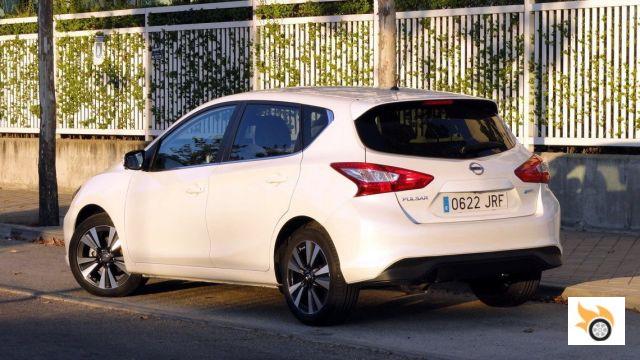
Let's start with the aesthetics. I've collected some opinions while I've had the two units on test; not a scientific survey, to be honest. As in everything that is opinionated, the spectrum of responses ranges from "horrendous" to "cool as hell". This is not a clue because the Nissan family has common aesthetic lines and some of its products are unquestionable sales successes.
Let's go to the market. It is true that the professional channels (renters and companies), suffer from certain inertia that leads them to acquire "the usual". Perhaps the fact that the transition between Almera and Pulsar, called Tiida, passed through this world without shame or glory, has harmed the current model. For these channels it should be a plus that the Pulsar is made in Spain and that's always a good thing: lower logistics costs, fluid availability of spare parts, provides employment here, etc..
And the private channel? Here, love is managed in a different way. The entry point for this market segment is partly the popularity of the product. And for a product to reach the heart of the buyer, there is advertising. I know I have a short memory, but I don't remember seeing a single Nissan Pulsar advert on TV in the last two years. I do remember those of its "long-legged" cousins (Qashqai, Juke, X-Trail), electric and even the smaller one. What I do remember is a discreetly sized poster, displayed in the Madrid Metro this winter, advertising a version equipped with navigation, called Navi (petrol), with an interesting value for money ... They are not the same cards. It seems that the brand has some responsibility for the lack of popularity of the invention.
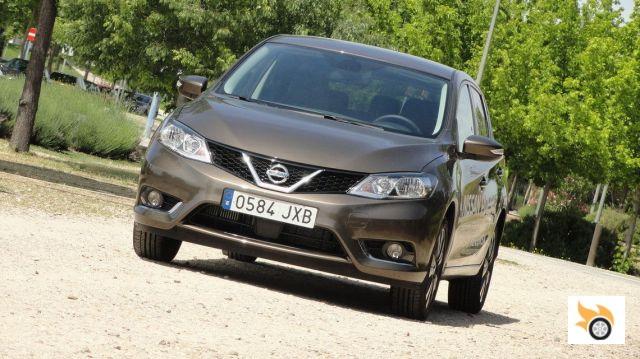
Design
The Nissan Pulsar currently on the market has changed a lot in appearance in relation to previous models, abandoning the smoothness and roundness of its ancestors in favor of a line with more pronounced and aggressive edges, fully in line with current trends and the other members of the brand; the "Nissan" seal is present in the design of this generation.
The Pulsar is a vehicle that for aesthetic purposes suffers, in my opinion, a certain lack of personality and more if we think of other products of the Japanese manufacturer. The Juke, for example, has a groundbreaking look. You can like it or not, but it's unmistakable. However, the Pulsar doesn't stand out for anything in particular. Maybe it lacks "spark", I don't know. In the B-segment model, the Micra, this has been taken care of much more.
Nissan Pulsar offers one of the best utilised spaces in the segment.
Among the most notable aesthetic features of the exterior of the Nissan Pulsar we have the set formed by the front lights and grille, which seem to outline a shy smile. The side view keeps some similarity of lines with some of his brothers, as Micra and X-Trail. The aerodynamic element of the rear roof is common within the brand. The voluminous rear light clusters of ripped air are another element of distinction. Details here and there, and little else. At least in the units tested with TEKNA equipment level, the highest of the offer, the windows behind the B-pillar were tinted, an aspect that stood out, along with the 17-inch wheels, compared to the color of both units.
However, the aesthetics are only part of the design. The arrangement and fit of the various elements and the use of space is also part of the design concept and here the Nissan Pulsar proudly boasts. In this model it can be said that the beauty is in the interior. The Pulsar offers one of the best used spaces in the segment, a rational and easy to learn layout of the controls, comfort and good acoustic insulation, as well as other details that elevate this car to a higher category than its sales level could imply. The result of these considerations is reflected in the grade given in the sections related to this chapter.
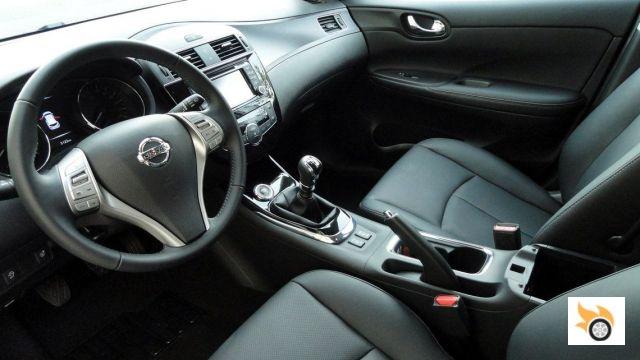
Interior
The C-segment has a certain dose of Benito's purge, trying to offer many things in a space that is just right for almost everything. When you first enter the interior of the Pulsar you realise that this car is different in its category. The real spaciousness, both in the front and rear seats, is unworthy of a "four meters" (as they used to say in the eighties). If the first impression is what counts, the interior of the Pulsar is an argument in its favour.
Once I've settled into the driver's seat, with the seat and steering wheel adjusted correctly, and after a quick inspection of all the controls, I always ask myself the same question: do I need an instruction manual? If the answer is yes, too bad... This is not the case. Any user with a minimum of experience will quickly identify what's inside the Pulsar and what it's for. The controls that can (and should) be operated on the move, are intuitively accessible without doing a simulator course. This is an important safety factor; a moment of distraction looking for a button can end in a passionate embrace with a lamppost.
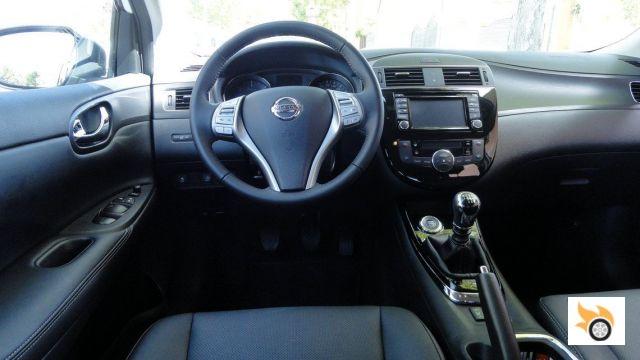
Let's start on the left. Above the door is the generous and always visible door-opening knob, accessible from the distance of a slightly outstretched arm. Below it, halfway up and slightly below the lower area of the steering wheel, are the controls for the electric windows, common in the four levels of equipment offered in our market - except for special promotions - which ordered from lowest to highest are: Visia, Acenta, N-Connecta and Tekna. In the same area are arranged the security door locking controls and mirror control.
Continuing to the right and already on the dashboard, at the height of the door opening control there is an adjustable ventilation grille. Below it, a single control to change the brightness of the instrument panel. Further down and less accessible (in this case, as it should be), there is a panel of switches with more or less buttons, depending on the level of equipment, to activate / deactivate systems such as electronic stability control (ESP), ECO mode, Stop / Start and some more, whose setting is better to decide for safety "before" than "during". Even lower down and more hidden are the fuel filler flap opening handle and the bonnet opening control.
The standard equipment of the most basic version is quite complete.
The instrument panel consists of three zones. On the left is the rev counter (with a different scale depending on the engine type: up to 6,000 RPM for the diesel and up to 8,000 RPM for the petrol), the temperature indicator and a handful of indicator lights. In the centre is a rectangular colour multi-purpose information display. To the right is the speedometer and fuel tank level indicator.
The steering wheel, adjustable in height and depth from the most basic equipment level (Visia), is one of the components of the Nissan Pulsar that I liked the most. Not so much for the finish (in leather, like the gear knob, from the Acenta trim level), but for the layout of all the controls: from the satellite controls, those integrated into the radios and the horn. I value this aspect very much, as I have already mentioned, for safety reasons. When the going gets rough we act on instinct and a proper layout of the controls can be the difference between a scare and a bump.
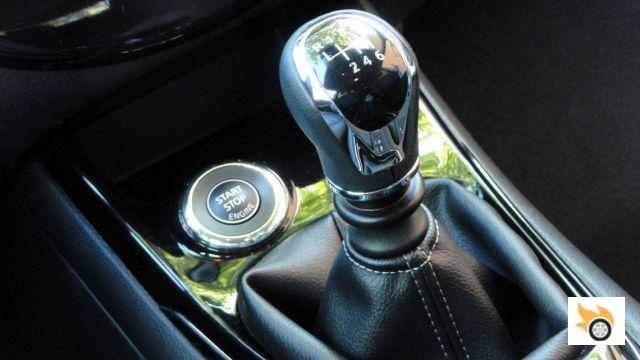
The satellite controls are common to other vehicles: light and turn signal control on the left and windshield wiper/washer on the right. As for those arranged on the radios, on the left side are those related to the control of the multifunction display (very easy to use) and audio switches. On the right spoke is the cruise control, speed limiter and integrated mobile phone (in the two higher versions of equipment that incorporate them: N-Conecta and Tekna).
The steering wheel, which operates an electric power steering system, houses in its central part the horn button and the driver's supplementary front airbag.
The central area of the dashboard is well populated. In the uppermost area is the hazard light button, located to be operated by both the driver and the passenger on the right. In the next section are the air vents, independent of each other. Under these the rock & roll begins, with a complete multimedia system that includes a CD player, SD card reader (for the navigation system mapping), high resolution touch screen, radio, auxiliary input, 3D navigation system and 360º vision camera. Of course, this last feature isn't available in full on all lower trim levels. The Navi special edition, the one advertised in the Metro, comes with almost everything. We'll come back to this in a few lines.
The two-zone climate control system (reduced to "simple" air conditioning in the Visia level), completes this central group. As for the climate control and its controls, it has its own screen and its operation is trivial; all its functions are in sight and the controls are unmistakably identified. It couldn't be simpler. The horizontal extension of the central area separates the two front seats. There we find the push-button ignition switch, the gear lever, the seat heater switches (if available) and the parking brake lever.
Against this paraphernalia of controls and technology on the driver's side, highlights the simplicity and spaciousness of the passenger area, from which you have good access to the center console with all its functions, but before it has a bare dashboard of smooth lines and a discreet glove box.
In these times when it seems that if you are not connected to social networks and the cyberworld, the car does not walk, Nissan offers a proprietary solution called NissanConnect. It is a system that combines Google services, an application for mobile phones (iOS / Android), and technology installed in the car itself in order to move routes to the navigation system, search, connect with some social networks (Twitter and Facebook), travel-related services via Tripadvisor and other information, such as Eurosport. It is not compatible with Android Auto or Apple CarPlay, it is a proprietary system.
NissanConnect system requirements are low
In favor of Nissan's system I have to say that, unlike other brands that have introduced such a level of sophistication that it requires the latest and most expensive smartphone to work, the NissanConnect system requirements are low and worked on an old 2011 phone to my complete satisfaction. Sure, they're also more basic, but it doesn't seem very coherent to have to buy a thousand euro handset to "pilot" such a system in a twenty thousand euro car... I think.
Let's jump to the rear seats. Theoretically there are three, but the central one is symbolic and uncomfortable as usual. However, the other two seats can easily accommodate king-size people and weights. The 692 mm available for the legs ensure the result; as well as spacious, they are comfortable. All equipment levels include the ISOFIX anchoring system in the rear seats.
The boot capacity ranges from 385 litres in its minimum configuration (a good figure in its category), to 1,385 litres with the rear seats folded down. A remarkable capacity for a compact of this size. The load floor is at an adequate height; the fifth door of the Pulsar reaches all the way to the rear bumper. We were pleased to find a spare wheel instead of a puncture repair kit.
Finally, it's worth noting the use of the various recesses, from the handy sunglass holder on the roof to the front and rear bottle racks. Nissan's designers haven't wasted any space.
Technology
For this test we have had two different engines with four turbocharged cylinders and similar power: the Nissan Pulsar DIG-T 115 hp petrol and Nissan Pulsar dCi 110 hp diesel. In both cases the transmission is a 6-speed manual.
The petrol engine is the Renault H5FT, with a displacement of 1,197 cc and four valves per cylinder. The bore to stroke ratio is 72.2 x 73.1 mm. The 115 hp of power is delivered at 4,500 RPM and the maximum torque is 190 Nm at 2,000 RPM. The compression ratio is 10:1 and the fuel system is direct injection. Several competitors have three-cylinders at this power level, both in this displacement and in one litre.
The diesel engine is also of Renault origin, the K9K, with a displacement of 1,461 cm³ and two valves per cylinder. The bore to stroke ratio is 76 x 80.5 mm. The 110 hp of power is delivered at 4,000 RPM and the maximum torque of 260 Nm between 1,750 and 2,500 RPM. The compression ratio is 15.5:1 and the fuel system is common rail injection. In the Euro 6 version, which we tested at its market launch, we noticed no difference with the Euro 5 version.
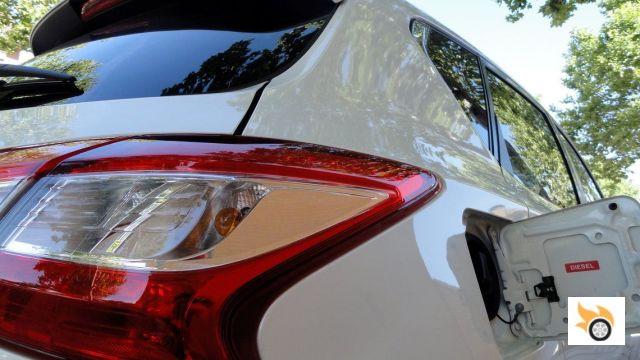
In addition to the two models tested on this occasion, there are two more petrol versions: one with automatic transmission called XTRONIC (115 hp) and a more powerful one (190 hp), which has also appeared in our pages. The four siblings have common elements that are described below.
The front suspension is independent McPherson type, and the rear has been resolved with torsion axle and springs. Power-assisted rack-and-pinion steering. The braking system has servo-assisted front and rear discs, with ABS with electronic brake distribution (EBD) and emergency brake assist as standard. The stability control system (ESP) is standard across the range. The 16-, 17- and 18-inch wheels are available, depending on version and trim level, with the following tyre sizes: 195/60 R16, 205/50 R17 and 215/45 R18. Our two test units were fitted with 17" wheels with Continental 205/50 R17 V tyres.
Turning to the two models tested, the petrol version reports a kerb weight without driver of 1,290 kg and 1,353 kg for the diesel version. The basic dimensions are common across the range: length 4,387 mm, width 1,768 mm and maximum height 1,520 mm. The wheelbase is 2700 mm. This generous wheelbase is responsible for the large interior space, which is also well used. The fuel tank capacity is also the same for all: 46 litres.
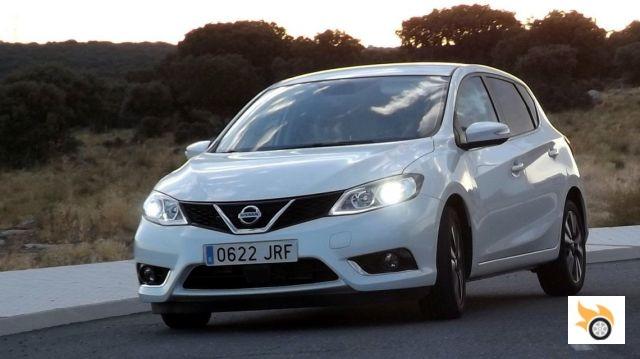
Driving
If the first impression when entering the interior of the Nissan Pulsar is positive, the second is not far behind. When both engines are started, the sound insulation is noticeable: even the diesel is barely audible in a garage. The only difference between the two engines in these circumstances is that the rear-view mirror vibrates a little more at idle speed in the diesel. When I shift into first gear and release the clutch, I'm pleased to discover that it's not a crazy goat and the manoeuvre is very smooth.
For the test, I tried to make the ride similar with both models, although as you will see later, the tester proposes and Fomento disposes. It was not possible. The distance covered with the diesel engine was 607.6 km, using a time of 14 hours and 20 minutes. The average speed was 46 km/h and the average real consumption was 4.3 litres/100 km according to the on-board computer. As for the petrol, 500 km were done exactly (not even if I wanted to do so), using 10 h 2 m, at an average speed of 49 km / h, with an average consumption of 6.3 liters/100 km.
In both cases the idea was to make a trip on motorways and highways with an average as high as possible within the speed limits. Doing the reverse route by a national road of second order, including a mountain pass, and the rest by highways around Madrid and pure and hard street. The route, despite knowing it perfectly, was designed on a PC and sent to the car's navigation system with the Send to Car service, which worked flawlessly; nothing to complain about.
One of the objectives was to test the goodness of the Stop/Start system and to what extent it saved emissions. Regarding this point, the system worked well with the diesel, where we managed to save -according to the car's system- 980 grams of CO2 (equivalent to less than 10 km). As for the petrol, any figure I say is an invention. It was working so badly that I decided to disconnect it. When I handed over the petrol and made the remark about the problems with the Stop/Start system, they explained to me that the functioning depends on external factors, such as the use of the air conditioning. I nodded with a straight face, thinking it was a bad excuse; during the test drive of the diesel it was hotter and I used the air conditioning constantly?
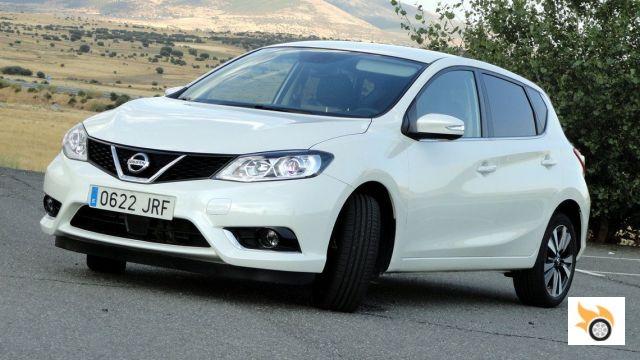
Let's go with the diesel Pulsar. If I wanted to sum up the experience in one sentence, I would say that I don't like petrol cars but I loved driving this one. The Nissan Pulsar dCI 110 hp has comfortable and precise steering. It brakes well (even using the brakes badly going down a hill). The clutch and gearbox are smooth. The gear selector lever is not the height of precision, but it scores well. The cornering behaviour is noble regardless of whether it's slow or fast and the suspension offers comfort without surprises in normal driving environments for the car's target users.
The diesel engine is a tried and tested solution, with fewer mechanical elements than other competing engines, and it uses little fuel. If the average was 4.3 l/100 km during the test, I'm sure that more relaxed drivers, who keep an eye on fuel consumption, can reach 4 l/100 km. All of these characteristics give the Pulsar diesel a family-friendly character.
So much for the good part; let's move on to the less good. One of the reasons for the low fuel consumption of this model is based on a gearbox with a long fifth and sixth gear. This virtue becomes a disadvantage at other times, especially on roads limited to 90 km / h that have constant changes of slope. Here the sixth gear is too long, recovering poorly from 80 km / h and the fifth is somewhat short. In these circumstances, either you change too often, or the car complains, or you increase consumption above what is desirable. In any case, it is difficult to reach the 90 km/h limit. The problem is aggravated with the air conditioning running. The petrol model doesn't have this problem. Here is some data on speed and engine speed in sixth gear for both engines:
| Speed (km/h) | 90 | 100 | 120 |
| Diesel (RPM) | 1.500 | 1.750 | 2.000 |
| Gasoline (RPM) | 1.750 | 2.000 | 2.500 |
The diesel was pleasant to drive because the Stop/Start system worked well and the smoothness of the car attenuates the stress of city traffic. With the petrol it was the opposite until I switched off the invention. Although the power ratings are almost identical, the higher "lows" of the diesel give it superiority over the petrol when it comes to stopping, starting and driving at low speeds. By the way, their ability to recover in third gear is the same, 7.4 seconds from 80 to 120 km/h.
The test would have passed with no more pain or glory except for the surprise in the form of a cut road that I found driving with the petrol model. I had already done the civilised motorway/highway section, I was on a secondary road and the fuel consumption was under control, with a reasonable 5.3 l/100 km. It was a sunny and beautiful day, and the sound of the Pulsar's multimedia system was good.
For reasons I don't know, there was a mandatory detour to another road of lower range and thanks to the bad signage I got into a worse one, a road whose existence I didn't know despite the years I've passed through the place. Narrow, winding, without shoulder, poorly paved and unmarked... Dangerous in short, if you look on the bad side, but with a whole world of possibilities if you like driving. And of course, you can't put a steak in front of a dog and expect it not to eat it?
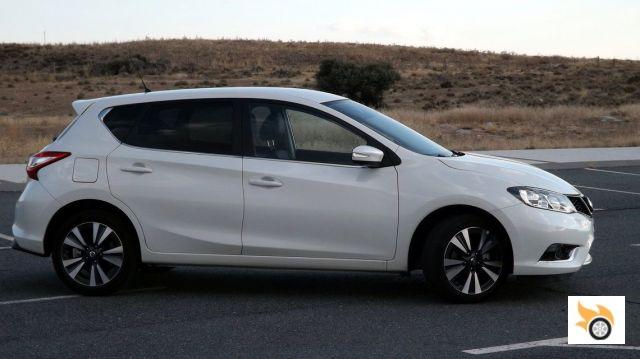
In some sections the visibility was so bad and the curves were so tight that going over 20 km/h was reckless. In others you could see everything for the next half kilometer or so, with curves, ravines and parties to keep. I'm sure I didn't exceed any speed limits, because there were no signs indicating them. I don't think I went much over 80 km/h or 4th gear either; the road and the car weren't big enough for more. But the rest, as you can imagine, was a free-for-all. The steering was precise when cornering, the brakes took the occasional voluntary stomp and the engine was asked to show its chest and it did. The rear end moved with a certain nervousness. It bounced, but nobly. Somewhat understeery in corners taken with a certain optimism. I didn't expect such agility in this kind of car.
The point of temperance was put by a motorhome that I saw arriving in time. Despite slowing down considerably both of us (I got to 1st gear) and speeding up the right side of the road, thanks to the difference in height we didn't tear off each other's mirrors. The bodies passed so close that I could swear they exchanged electrons. That's how narrow the road was. It was the only vehicle I encountered on that stretch.
The Nissan Pulsar's laid-back, touring nature can get racy and do it safely.
The consequences of the stress test were reflected in the fuel consumption, which at the time was around 8 litres/100 km. Between 20 and 30 minutes in those circumstances hurt the test average. The rest of the trip was normal. The upside of the downside was to prove that the Pulsar's quiet, travelling nature can turn racy and do so safely.
Returning to the common part of the test, I would like to highlight the good performance of the automatic lighting control, which is quick to switch between high and low beams, both when entering a garage or a tunnel, as well as in head-on traffic on the road. Another plus point is the GPS navigation system, whose precise and clear instructions make it easy to drive on unfamiliar roads. On a positive note, significant changes in trajectory are also indicated on the rectangular display in the main instrument panel. A quick glance focuses you on what you need to do, without looking away from the main screen on the centre console.
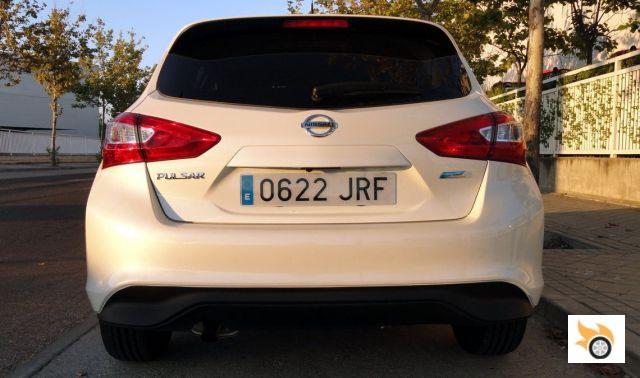
Conclusions
After 1,100 km in the two flavors of Nissan Pulsar of similar power, the experience invites me to think that the market is not being fair to this car, whose quiet and somewhat bland appearance hides a good product that surprises for good. I doubt that my needs will turn to the compact C-segment, but if they do, the Pulsar would be an interesting option. I might even consider buying the diesel using my reason, because with my heart I'm going straight for the petrol.
The price difference for the diesel is small, just over 1,500 euros.
In front of the virtues mentioned above, there are other doubts about the quality of the finish. The light control lever of the petrol was quite damaged even though the car had 2,200 km on it. Either someone has made a lot of donkey or the element in question is somewhat soft; at the slightest change of position jumping the turn signal. Another detail, common in both units, is the lack of precision of the system that controls the fuel level. When the range is close to 68 km it stops marking, and when it's full the needle stays still for almost 300 km.
During a trip on unusual routes, without knowing where there is a petrol pump, the anguish can be considerable. The fuel consumption of the petrol engine doesn't seem reasonable either. It's a twelve hundred with the consumption and power of a sixteen hundred not very tight. I don't see the advantage of downsizing. I clarify that the score reflected in the section "consumption" and "performance", are the result of applying our formula to the diesel engine; the petrol engine would get a score of 89 and 7 points respectively.

























